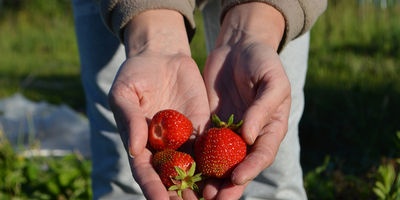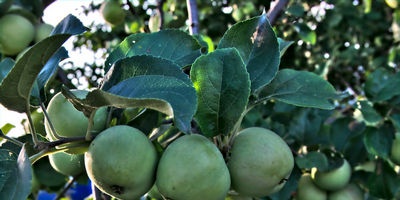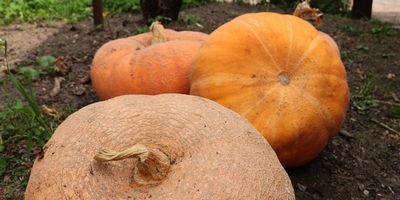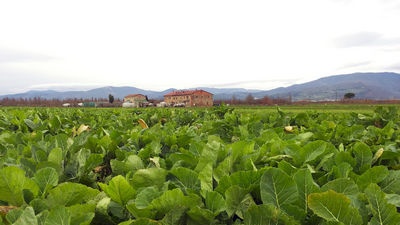|
 Plots of 8 to 12 acres are usually allocated for individual development in cities and workers' settlements. Household plots in rural areas can reach 25-30 acres (and more). Plots of 8 to 12 acres are usually allocated for individual development in cities and workers' settlements. Household plots in rural areas can reach 25-30 acres (and more).
A significant part of the area is used for a garden, vegetable garden and decorative plantings.
Developers-gardeners first of all have questions: how to build a house, how to place outbuildings, where to plant an orchard, to grow a vegetable garden, to arrange decorative plantings. To avoid mistakes, it is necessary to draw up a project for the development of the site.
In the practice of individual housing construction, a strong tradition has already developed to place the windows of the facade of the house (dining room, living room) towards the street, and the windows of the bedroom and work room towards the depths of the estate. Terraces and verandas in our relatively cool summer are built closer to the garden and green spaces, usually on the east or west, less often on the north side of the building. It is better that the entrance to the house is from the side of the entrance to the estate. Sheds, outdoor latrines, garbage bins, compost heaps, cesspools, as well as premises for livestock and poultry on collective farms' personal plots must be located behind residential buildings, in the depths of the estate. They must be isolated from housing, wells, reservoirs, removed from the street,
Between the house and the red line, the streets give a gap of at least 2-3 m. flower garden. Fire breaks are left between the buildings of adjacent areas, usually 10-15 m.
The issue of supplying the site with water in collective gardens is most often decided in the order of improvement of the entire village (wells, water supply). Regardless of this, for watering plants in the garden and vegetable garden, it is good to have their own open reservoirs or water intakes, in which the water would have time to heat up in the sun during the day. It should be borne in mind that in a hot summer you have to water the plants after five to six days and each time consume up to 20-30 liters (2-3 buckets) of water per square meter of the garden and mainly the vegetable garden. This makes it possible to calculate how much water is required for irrigation and what capacity the reservoir should be arranged on the site. In some cases, the owners of the estate create local wells, but this is only possible when the water is shallow.
 It is important that the space between the red line of the street and the housing is landscaped. It is advisable to plant ornamental plants not only around the house, they are also needed near outbuildings. This will create the appearance of a beautiful, well-maintained estate. It is important that the space between the red line of the street and the housing is landscaped. It is advisable to plant ornamental plants not only around the house, they are also needed near outbuildings. This will create the appearance of a beautiful, well-maintained estate.
However, planting ornamental plants around your home should not be overused. In particular, do not plant them close to the house, as it will be too shaded by greenery. Free access to light and air must be provided to windows and walls.
It is advisable to place fruit and berry plantations directly behind residential or outbuildings, and vegetables, potatoes and garden strawberries it is better to plant in the far part of the site. Approximately the same principles for the placement of buildings and plantings should be adhered to in collective gardens in areas assigned to gardeners. Thus, when planning the use of land plots, it is necessary to outline the following sectors: residential and farm buildings, ornamental plantings (trees, shrubs, perennial and annual flowers), a garden (fruit and berry crops), a vegetable garden (vegetables and potatoes).
Among fruit and berry plantations at a distance from housing can be placed apiary (mainly pollinating, from two or three hives).
The location and size of each of these sectors depend on the needs, material capabilities and taste of the land user, as well as on the requirements of local Soviets of Workers' Deputies, communal bodies that exercise control over the development of household and collective plots. ...
When creating a garden and a vegetable garden on a personal plot, the worker takes into account, first of all, the needs of his family for fruits, berries and vegetables. How do you calculate this need?
The average daily allowance will be about 250 g of fresh fruits, berries, compote, jams, juices. For a year, a family of four or five people will need 350-450 kg of fruits and berries.
This amount of products can be obtained from a plot of 400-600 square meters. m (4-6 acres) with an average yield of fruit and berry crops of 1-1.5 kg per square meter. And this is certainly quite real. With more skillful care of plants from the same area, you can get a higher yield.
Rationally using their personal plot, the family can get from it a sufficient amount of vegetable products. According to calculations, to meet the annual need of one person in vegetables and potatoes, land is required: for planting tomatoes, peppers, eggplants - 7.5 sq. m, root crops (carrot, beets) - 9, melons (cucumbers, zucchini, melons, watermelons) -8, legumes (peas, beans, beans) - 9, late and early potatoes - 50 and various vegetables - 2.5 sq. m. In total, you need 86 sq. m, and for a family of four to five people - 350-450 sq. m.
 Using the above data, you can easily calculate how much area you need to take with fruit and berry plants, what kind of garden and what crops and varieties it is more advisable to plant on a personal plot, so that the family, if possible, would be provided with fruits, berries, potatoes and vegetables throughout the year. Using the above data, you can easily calculate how much area you need to take with fruit and berry plants, what kind of garden and what crops and varieties it is more advisable to plant on a personal plot, so that the family, if possible, would be provided with fruits, berries, potatoes and vegetables throughout the year.
The plan should also provide for the sequence of the location of fruit and berry and ornamental plantings. The owners of many household plots, for example, when developing them in the Moscow region, make the same mistake: they do not place fruit and berry crops separately, as they should, but lay mixed gardens, that is, they are planted between tall fruit trees cherries, plums, berry bushes, strawberries. They try to justify such a combination of crops by the fact that thickened plantings create a more favorable microclimate in the garden, reduce the evaporation of moisture from the soil and contribute to a better accumulation of snow; they believe that from the very first year they will ensure a more productive use of the garden area, reasoning as follows: while the fruit trees are not yet bearing fruit, stone fruit trees and berry bushes planted in aisles will begin to bear fruit, which will pay off the labor and material costs invested in them.
Thinking this way, novice gardeners forget that when the fruit trees grow and enter the season of fruiting, undersized stone fruit and berry plants in the aisles will be oppressed and gradually lose their productivity. It will be difficult to remove them from the aisles, and there is nowhere, since the entire area of the estate by that time will be occupied entirely. As a result of such land use, valuable early-growing and early-ripening crops can be forced out of personal plots. And this is completely undesirable.
It is impossible to excessively reduce the feeding area of fruit and berry plants. When they are grown compacted at the age of productive fruiting, conditions of competition are created between the root systems of fruit trees and berry bushes for soil nutrition and moisture, and between their crowns for light, heat and air.
It should always be remembered that in thickened plantings, the wood of the plants turns out to be loose, the trees stretch out, the skeleton of the crown is unstable, low-strength. Inside the crown, bareness is noticeable, fruit formations do not develop there; The crop is carried to the periphery of the crown and sharply decreases, the fruits become smaller.In a thickened garden, plants are poorly ventilated and are more easily affected by fungal diseases, especially scab. In addition, in compacted gardens it is also difficult to protect plants from pests and diseases: when processing tall-growing trees, poisonous solutions or powders can get on lower-growing shrubs and strawberries.
In order for all fruit and berry crops to grow productively, it is necessary to plant them separately, providing a specific place for each of them in the placement plan. This, however, does not in the least exclude the possibility of temporary use of the aisles of the orchard for several years for growing strawberries and vegetables.
It is equally important to place the plantings in accordance with their requirements for sunlight. Garden and vegetable crops are overwhelmingly light and heat-loving. Only raspberries and, in part, black currants can put up with some shading. Therefore, all garden and vegetable plants should be arranged so that they are as best illuminated as possible by the sun, less shade and oppressive one another. It should also be provided that the landings do not create excessive shading in the neighbor's area. Trees and shrubs can be planted at the border of a neighboring garden no closer than half the distance taken for planting each crop, so that the crown of each plant does not subsequently go beyond the established border.
 On the southern side of the site, it is advisable to plant less tall plants - stone fruits, and then pome fruits, higher ones. For apple trees, you can plant black currants (shade-tolerant), then gooseberry and red currants. With this arrangement, less tall plants are gradually replaced by higher ones, which provides better sunlight for all fruit and berry crops growing on the site. On the southern side of the site, it is advisable to plant less tall plants - stone fruits, and then pome fruits, higher ones. For apple trees, you can plant black currants (shade-tolerant), then gooseberry and red currants. With this arrangement, less tall plants are gradually replaced by higher ones, which provides better sunlight for all fruit and berry crops growing on the site.
You can also plant tall plants in the middle of the plot in the direction from north to south, and lower bone and berry bushes along the edges. With this arrangement, all plants will be maximally illuminated at noon, as well as at sunrise and sunset.
When placing plants on the site, the characteristics of different varieties of the same crop should also be taken into account. For example, the apple tree of the Pepin saffron variety has a wider crown and less high crown than that of Antonovka and Streyfling, and Papirovka's crown is more pyramidal and high. Pears reach especially high heights, but their crowns are narrow. Cherries of varieties Lyubskaya, Polevka and Fertile Michurina are much lower than Vladimirskaya and especially Shubinka. All these differences should be taken into account when planting, placing the plants so that the taller and more powerful ones do not shade the small ones if possible.
Other options for planting fruit and berry, ornamental and vegetable plants can be used depending on local characteristics. But one must always keep in mind that they will grow well and bear fruit only if they are provided with favorable conditions of humidity, nutrition and sunlight. Therefore, when drawing up a project for the development of a site, it is necessary to take into account what size the plants will reach during the period of full fruiting (15-20 years), and not proceed only from their state at a young, infertile age.
Errors in the layout of the garden, discovered several years later, are very difficult to correct. Not everyone will dare to uproot the plants he has nurtured, to part with the trees grown at the cost of great effort. It is better to take a closer look at the plan for the placement of plantings and avoid the annoying mistakes that many novice gardeners often make.
K. S. Dukhanin
|
 Plots of 8 to 12 acres are usually allocated for individual development in cities and workers' settlements. Household plots in rural areas can reach 25-30 acres (and more).
Plots of 8 to 12 acres are usually allocated for individual development in cities and workers' settlements. Household plots in rural areas can reach 25-30 acres (and more). It is important that the space between the red line of the street and the housing is landscaped. It is advisable to plant ornamental plants not only around the house, they are also needed near outbuildings. This will create the appearance of a beautiful, well-maintained estate.
It is important that the space between the red line of the street and the housing is landscaped. It is advisable to plant ornamental plants not only around the house, they are also needed near outbuildings. This will create the appearance of a beautiful, well-maintained estate. Using the above data, you can easily calculate how much area you need to take with fruit and berry plants, what kind of garden and what crops and varieties it is more advisable to plant on a personal plot, so that the family, if possible, would be provided with fruits, berries, potatoes and vegetables throughout the year.
Using the above data, you can easily calculate how much area you need to take with fruit and berry plants, what kind of garden and what crops and varieties it is more advisable to plant on a personal plot, so that the family, if possible, would be provided with fruits, berries, potatoes and vegetables throughout the year. On the southern side of the site, it is advisable to plant less tall plants - stone fruits, and then pome fruits, higher ones. For apple trees, you can plant black currants (shade-tolerant), then
On the southern side of the site, it is advisable to plant less tall plants - stone fruits, and then pome fruits, higher ones. For apple trees, you can plant black currants (shade-tolerant), then 








